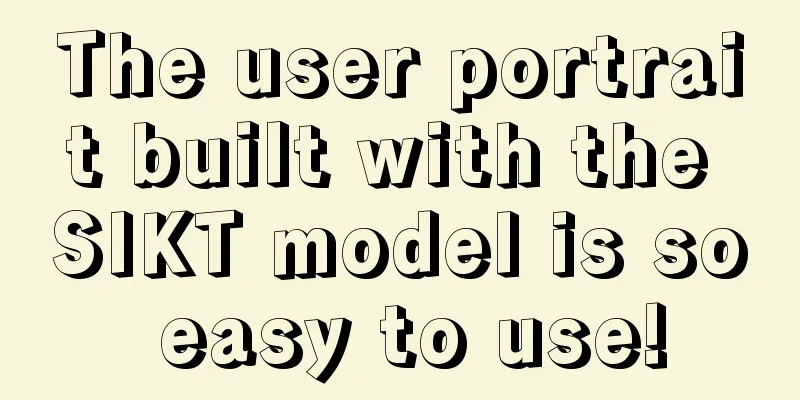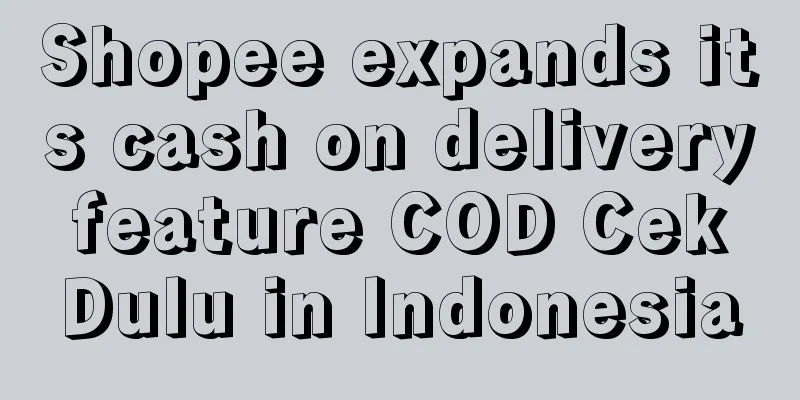The user portrait built with the SIKT model is so easy to use!

What do you fear the most when doing user portrait projects? Three words: no! It’s useless! Often, students who work on data work hard all day to output the so-called “360-degree user portrait” and then get criticized by the business side: So what if you know gender and age! Consumption was high in the past, but what about the future? If you mark something as high potential, does it really have high potential? ? All of the above problems are caused by not promoting the project based on the SIKT model. The user portrait is out of touch with the business scenario, and there is no consideration of what the business can do with the portrait. If you want to break through, you must return to the business scenario and think seriously: What can user portraits do? The SIKT model is a set of conceptual models (not algorithmic models) to solve this problem. 01 SIKT model principleThe SIKT model is a method for sorting out labels. Labels are the basis of user portraits and the building blocks of the portrait system. If you want the user portrait system to be useful, the labels themselves must be valuable. This requires that when labeling, you cannot rely on the intuition of data personnel and randomly put "gender, age" into the system like a running comment, but start from the business scenario and progress step by step.
The labels sorted out according to this step are easy to observe:
It should be noted that labels are not omnipotent, and some business scenarios may not require labels. Therefore, the first step in using this method is to sort out business scenarios and find those that are highly relevant to labels. 02 Business scenario analysisEssentially, a tag is a condensed set of business information. Compared with uncondensed information, tags have three major advantages:
In summary, almost all business work involves three steps: understanding the current situation, formulating strategies, and choosing methods. Therefore, only industries that are still in the process of rapid development, staking out territory, and growing wildly do not need labels. If it is still growing wildly, then why bother searching, classifying, and selecting? Just throw money at it and do it! Whenever the industry growth slows down and needs to control costs and increase efficiency, labels are useful. 03 1 small application caseScenario 1: The advertising department of an Internet company plans to select influencers for private domain advertising. The indicator of the delivery scenario is very clear: delivery conversion rate. It should be noted that since it is a private domain delivery, after buying the advertising space of a big V, it can only cover all the fans of the big V, and it is impossible to group users in the decision-making stage. Therefore, when splitting the scene, it is impossible to use label optimization in the decision-making stage. However, labels can help in the stages of understanding the current situation and choosing methods. Cognitive stage: There are many influencers, and one influencer covers all platforms. At this time, if there are tags to classify influencers, you can easily check the basic information of the influencer and select the appropriate influencer. Selection stage: For the same ad, there may be 5 or 6 different materials that can be used. At this time, if there are tags to classify the materials, it can reduce the difficulty of screening and improve efficiency. Note that the labels used here are not 100% user labels. For example, the big V classification labels may need to be marked by colleagues in charge of promotion. For example, material labels may need to be marked and classified by colleagues in charge of material design. Note that the labels used here are not generated all at once. For example, the "cheating" label in the big V label was marked after the big V was found to have cheated in the previous cooperation to prevent future people from being fooled. For example, the "use effect" label in the material label was marked after observing the effect of the material delivery N times. This leads to a deeper problem: User portrait construction is not something that can be done by an invincible data analyst who can create a database one day. The classification of business and the tracking of results require a long period of accumulation and the participation of business colleagues to complete. 04 Let’s look at another small caseScenario 2: User operations of an Internet company plan to wake up dormant users with the goal of activating a purchase (regardless of the amount). In this scenario, the key indicator is very clear, which is the activation rate of dormant users. When segmenting scenarios, you will find that it is easier in the cognitive stage because the dormant user group has been locked in. However, it is more complicated in the strategic stage. Firstly, before going dormant, users’ consumption habits and experiences are different, so it may be necessary to distinguish user characteristics and find activation plans that are suitable for them. Secondly, being dormant at present does not mean being dormant in the future. Users themselves have a certain probability of natural return. If these naturally returning users cannot be distinguished, it is very likely that all the wake-up resources invested will be taken away by others. Therefore, at the critical action level, two important aids are needed:
Both of these points correspond to the need for labels. However, the implementation methods are different: Past demand analysis has data to rely on, so user stratification/grouping can be performed based on historical data. However, future wake-up situations need to be predicted, which requires the support of algorithm models. What’s interesting is that after we have truly predicted who will consume, we will bypass these predicted consumer users when delivering wake-up resources, so that the ROI calculation afterwards will look good. This leads to a deeper topic: how to create and use prediction models is also closely related to business scenarios. When many people build user portraits, they do not consider business scenarios and simply expect a "prediction model/recommendation model" to cover everything. This is very unrealistic. 05 SummaryTo sum up the entire SIKT operation process, we can see that if you want the user portrait to be effective, the label must be effective first. To make the tag effective, you need to:
In short, only when everyone works together can we truly achieve results. If we rely on a single data analyst and the few fields in the existing database, build models without considering business scenarios, and discuss data collection without considering business actions, we can only obtain a useless portrait like the one at the beginning, which is cut flat without leaving any blood. Author: Down-to-earth Teacher Chen WeChat public account: Down-to-earth Teacher Chen (ID: gh_abf29df6ada8) |
<<: 4 tags to build high-quality user portraits
>>: This is the real user portrait. Yours is just a list of gender, age and region.
Recommend
Kill them! This is how data empowers operations
In the digital age, data has become the core drivi...
How does DHgate.com do cross-border e-commerce? Which markets does it target?
As a cross-border e-commerce platform, DHgate.com ...
How did JD.com perform in the assignment of 10 billion yuan in subsidies?
On March 6, the JD.com "10 billion subsidy&qu...
How much profit should be added to the supply price of Temu? How is the price determined?
When operating cross-border e-commerce business on...
Betting on athletes, which brands win?
In this dual competition of sports and business, h...
The complexity of marketing: Blue Moon, Meijia Landou, Apple and Baidu
Recently, Blue Moon's marketing has caused a n...
30 years of Internet recruitment: a war for efficiency
Internet companies are not only competing fiercely...
Which site is better for cross-border shopping on Shopee? Any recommendations?
Shopee's cross-border e-commerce platform is c...
What is Amazon Seller Wallet? What are the advantages?
At the Amazon Global Selling Cross-border Summit, ...
Can Shopify use its own domain name? How to buy a domain name?
After building a Shopify website, sellers need to ...
5000 words sharing, taking Python class as an example, how AI can empower vocational education and achieve cost reduction and efficiency improvement
With the development of K12 education, there are m...
The second half of Xiaohongshu’s bonus has begun!
Now more and more people are starting to use Xiaoh...
Tomato short dramas are rising strongly, and Douyin has formed a group to harvest the short drama market
Recently, ByteDance has invested heavily in the ex...
How to pay with Afterpay? How to use Afterpay?
Afterpay is an Australian payment technology compa...
To overcome anxiety, how can brands seize the trend of relaxation and win the hearts of consumers?
This article introduces in detail the relaxation a...









